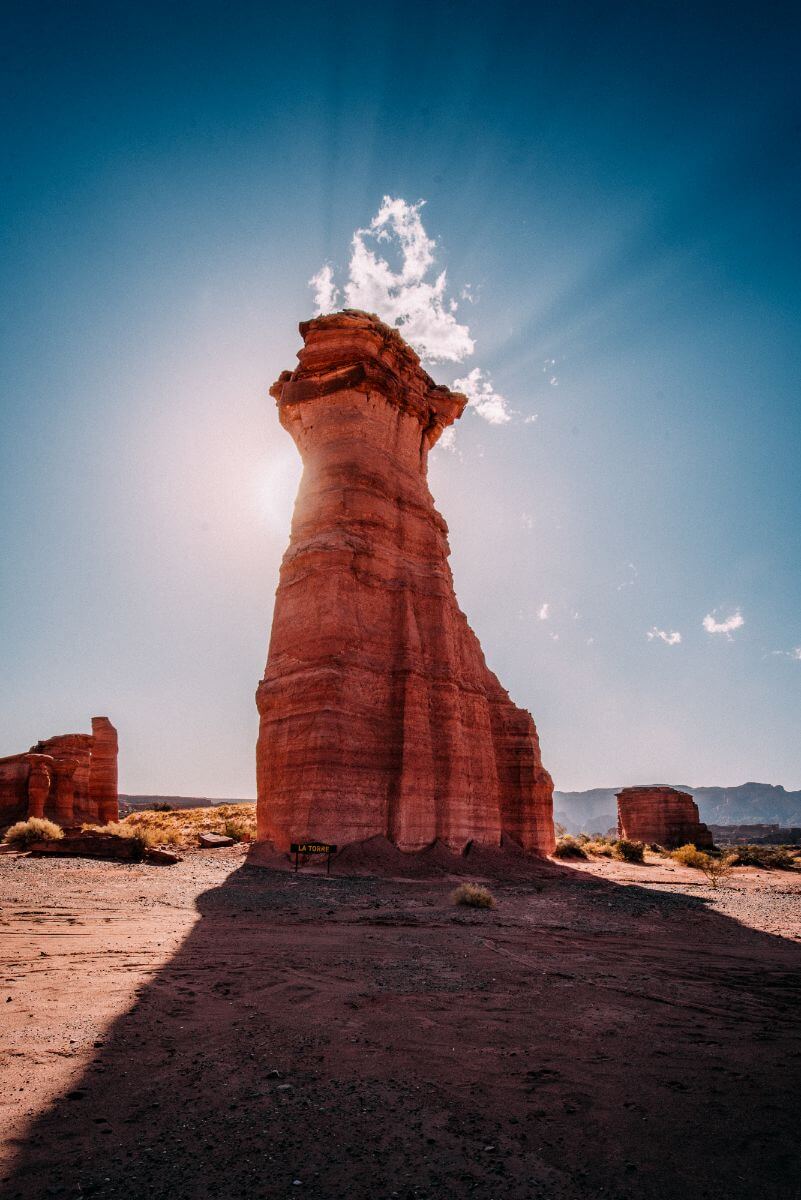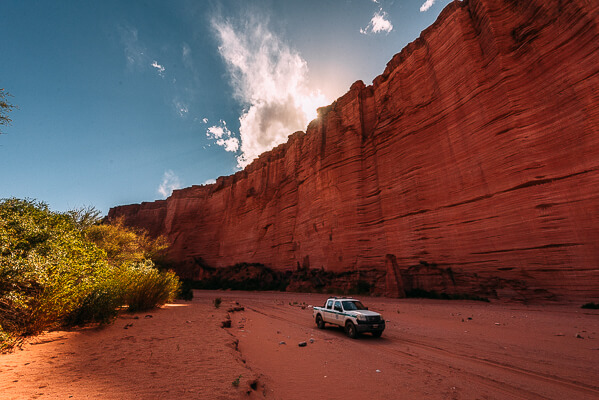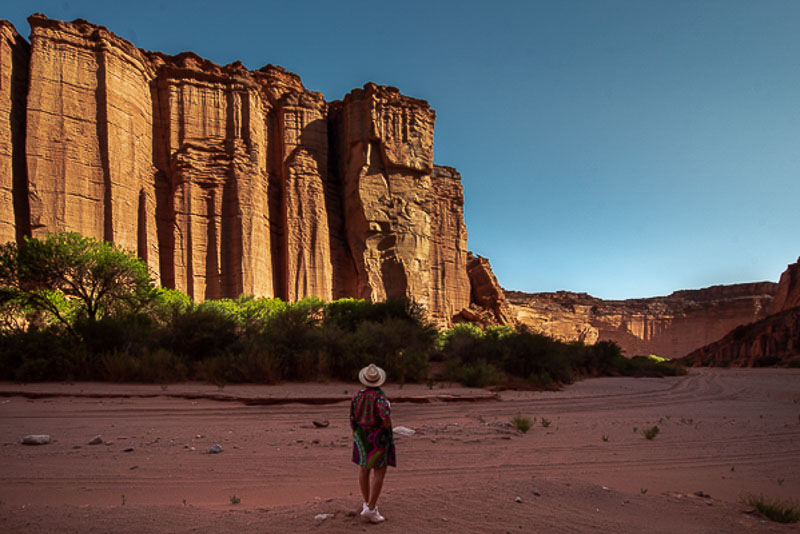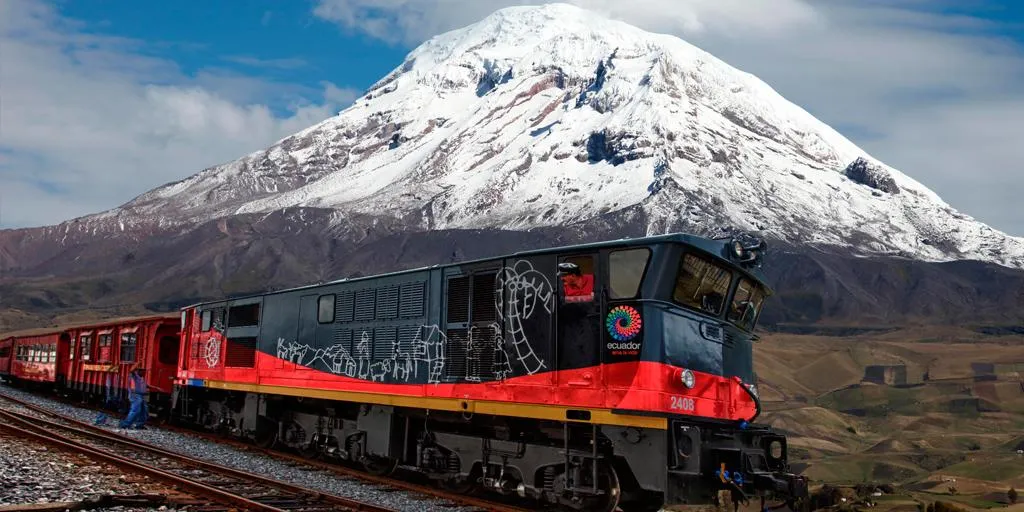Situé dans la province de la Rioja, le parc national de Talampaya est un trésor bien gardé dans le pays du bout du monde. Des paysages de rêves, des légendes anciennes, des couleurs éclatantes en ont fait avec les honneurs l’une des sept merveilles naturelles du pays et un site naturel classé par l’UNESCO!
Talampaya signifie “rivière sèche du micocoulier épineux” dans la langue des peuples autochtones de la région. Il s’agit d’un cours d’eau asséché en raison de l’aridité du lieu, et le micocoulier épineux est l’un des arbres les plus courants de La Rioja. Pourtant, au-delà de son sens littéral, la véritable définition du parc national de Talampaya ne peut s’élaborer qu’en s’aventurant au cœur de ses parois de roche rouge, de ses formes fantasques et de la magie que cache son ciel d’un bleu profond, des tons verts des arbres qui exhalent l’oxygène qu’offre ce lieu magique : une véritable œuvre d’art naturelle.

Pour toutes ces raisons, et bien d’autres encore, il n’est pas étonnant que le parc soit considéré comme l’une des sept merveilles naturelles de l’Argentine. Il remplit toutes les conditions nécessaires pour figurer dans le classement : paysage spectaculaire, originalité géologique, biodiversité, durabilité, accessibilité et potentiel. Des mots qui vont de pair avec l’essence de cette destination incontournable. En 2019, elle a gagné sa place parmi d’autres géants, comme la forêt tropicale de Misiones (Misiones), la rivière Mina Clavero (Córdoba), les Salinas Grandes (Jujuy et Salta), Bañado de la Estrella (Formosa), le parc national Nahuel Huapi (Río Negro) et le glacier Perito Moreno (Santa Cruz).
Voici quelques-unes des raisons pour lesquelles vous devez découvrir Talampaya :
Le pays des dinosaures
Les fissures des parois rocheuses rouges de Talampaya cachent les histoires les plus anciennes de toutes, celles qui remontent à l’ère mésozoïque et aux géants qui vivaient il y a encore 180 millions d’années. Se promener sur les terres de l’un des parcs les plus passionnants d’Argentine revient à suivre les traces des dinosaures. Ce trésor national ancien, puisque les vestiges archéologiques datent pour certains de plus de 225 millions d’années. Les fossiles sont d’importance mondiale et attirent dans ce paradis, géologues, scientifiques et spécialistes du sujet afin d’y mener leurs recherches. Les amateurs de vestiges de l’histoire ancienne ne peuvent donc pas manquer cette visite unique en son genre !
Un spectacle visuel unique

Appareil photo en main : c’est la règle N. 1 si la boussole pointe vers la province de La Rioja et, plus précisément, vers le parc national de Talampaya. Les opportunités photographiques abondent sur cette surface rocheuse : ses rouges intenses décorent la scène, la transformant en un univers parallèle à la Terre. La couleur rougeâtre s’échappe parmi les formes curieuses des parois rocheuses qui atteignent 150 mètres de haut, ce qui donne un spectacle merveilleux sculpté par les rafales de vent. L’eau a également joué son rôle. Un travail d’équipe qui a créé des sculptures naturelles. Au milieu de parois cuivrées assorties au bleu du ciel, s’élèvent des figures géologiques qui captent l’attention des visiteurs. Les plus populaires de la région sont El Monje et El Rey Mago, qui se détachent au milieu du désert rouge le plus imposant d’Argentine.
Une expérience à vivre au clair de lune
Pour prolonger l’expérience, pourquoi ne pas découvrir le parc sous les étoiles ? Camper au clair de lune ? Tout cela est possible dans ce parc national qui dispose d’un camping avec des douches, électricité, grils et services d’alimentation. Tout ce dont vous pouvez avoir besoin pour profiter d’une soirée où le ciel étoilé est la figure principale de la scène, dans un silence qui marque le rythme de la nature ; le calme, pour apprécier l’environnement et le garder en mémoire ; et le clair de lune, tel un phare, qui illumine et reflète les ombres sur la terre rouge.
Un voyage dans le temps à la découverte de l’art rupestre
La culture préhistorique est présente avec un langage différent, qui a été immortalisé dans les centaines de roches du parc. Les pétroglyphes se trouvent sur des visages, des rochers et recoin qui constituent de véritables galeries d’art rupestre, ajoutant une valeur supplémentaire à la découverte du parc naturel. Les formes et les dessins gravés témoignent de la présence d’anciennes civilisations qui ont habité la région, et la lecture de chacun de ces messages dévoile des détails sur leur mode de vie, leurs habitudes et leurs traditions : une expérience passionnante.
Source : Visit Argentina







